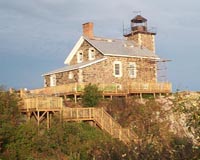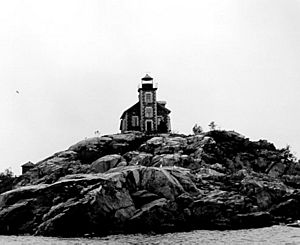Granite Island Lighthouse facts for kids
 |
|
| Granite Island lighthouse | |
|
|
|
| Location | Granite Island, Michigan |
|---|---|
| Coordinates | 46°43′15″N 87°24′43″W / 46.72083°N 87.41194°W |
| Year first constructed | 1868 |
| Year first lit | 1869 |
| Automated | 1937 |
| Construction | granite |
| Tower shape | bell tower attached "church style" to 2 story lighthouse keepers dwelling |
| Markings / pattern | red brick with white lantern |
| Height | 40 feet (12 m) |
| Focal height | 93 feet (28 m) |
| Original lens | Fourth order Fresnel lens |
| Range | 10 nautical miles (19 km; 12 mi) (new tower) |
| Characteristic | white flash 6 seconds. |
| ARLHS number | USA-333 |
| USCG number | 7-14700 |
The Granite Island Lighthouse stands on Granite Island in Lake Superior, off the coast of Michigan. It was built in 1868 by the U.S. Lighthouse Board and first lit in 1869. This lighthouse was very important because it was located near busy shipping routes in the mid-1800s.
Contents
Building the Lighthouse
The lighthouse building and its square tower are made from cut stone. They have white limestone decorations around the corners and windows. The main building, where the lighthouse keeper lived, is 11⁄2 stories tall. Its design is similar to other lighthouses in the area, like those on Gull Rock and the Huron Islands.
A special building for a Fog Signal was added in 1910. This new building replaced an older one from 1879. It was made of strong steel and held a large fog bell. This bell had actually been used at the Thunder Bay Island Light before it moved to Granite Island.
Life as a Lighthouse Keeper
Lighthouse keepers and their assistants worked at Granite Island Light for many years. Their job was to make sure the light and fog bell helped ships navigate safely. In 1937, the lighthouse became automated. This meant machines took over the work, and keepers no longer needed to live there. The living quarters were then left empty.
The lighthouse used a special light called a 4th order Fresnel lens. This type of lens was very advanced and helped make the light brighter and more visible. The light was 89 feet (27 m) above the water. At one point, it would flash red every 90 seconds.
New Owners and Restoration
Over time, modern navigation methods changed. Shipping lanes moved further out into Lake Superior. This made the lighthouse less critical for the U.S. Coast Guard. They decided to sell it to a private owner.
In 1999, Scott and Martine Holman bought Granite Island and its lighthouse from the U.S. Coast Guard. They spent three years carefully restoring the property. The old house was completely taken apart and rebuilt. All the old materials were boated away, and new ones were brought in.
Living on Granite Island is quite a challenge! For example, the owners have to bring all their fresh water to the island by boat. They also use special composting toilets because of the remote location. This means they don't have many visitors. The island's website, www.graniteisland.com, shares live camera views, history, and videos of the restoration.
The sale of Granite Island helped inspire a new law. The U.S. Congress passed the National Historic Lighthouse Preservation Act in 2000. This law makes it easier for communities and charities to buy old lighthouses instead of private individuals.
Modern Uses of the Island
Even though it's far away, Granite Island is a beautiful place. Its unique shape and colors make it a popular subject for photos and drawings.
The island is also used for important scientific and educational projects:
- Internet Station: Northern Michigan University uses the island as an Internet relay station. This helps provide live online classes to students in the nearby rural area of Big Bay.
- Weather Research: The Holmans have given a special weather research station to Northern Michigan University. This station studies how much water evaporates from the Great Lakes. The information helps the National Weather Service predict weather near the shore.
- Writing Retreats: The living quarters of the lighthouse are used by Northern Michigan University's English Department. They offer creative writing retreats there for students and faculty.
Getting to the island can be tricky because the water can be rough. Transportation is provided by two special boats called Zodiacs, which are 24 and 30 feet long. They travel about 12 miles south to the Marquette Lower Harbor.
The island's power comes from renewable sources. It uses solar panels and wind generators. Propane generators are available as a backup. These systems can be controlled remotely all year round.
While the island is privately owned, the U.S. Coast Guard still maintains an automated light. This light is on a gray steel tower and is 96 feet (29 m) above the water. It can be seen from 10 nautical miles (19 km; 12 mi) away and flashes white every 6 seconds.
Michigan has more lighthouses than any other state, with over 150 past and present lighthouses. You can learn more about them at Lighthouses in the United States.
The strongest wind ever recorded on Granite Island was 143 miles per hour (230 km/h) on January 18, 2003.
The best way to see this lighthouse is from the water. Remember, the island and lighthouse are privately owned and are not open to the public.



